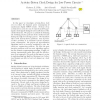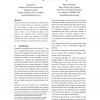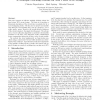433 search results - page 1 / 87 » Activity-driven clock design for low power circuits |
ICCAD
1995
IEEE
13 years 8 months ago
1995
IEEE
In this paper we investigate activity-driven clock trees to reduce the dynamic power consumption of synchronous digital CMOS circuits. Sections of an activity-driven clock tree ca...
ASPDAC
2008
ACM
13 years 7 months ago
2008
ACM
Traditionally, clock network layout is performed after cell placement. Such methodology is facing a serious problem in nanometer IC designs where people tend to use huge clock buff...
ISLPED
2000
ACM
13 years 8 months ago
2000
ACM
This paper presents a state assignment technique called priority encoding which uses multi-code assignment plus clock gating to reduce power dissipation in sequential circuits. Th...
TCAD
2011
12 years 12 months ago
2011
—Pre-bond testing of 3-D stacked integrated circuits (ICs) involves testing each individual die before bonding. The overall yield of 3-D ICs improves with pre-bond testability be...
ISLPED
1995
ACM
13 years 8 months ago
1995
ACM
This paper presents an e
ective multiple clocking scheme for lower power RTL circuit design. The basis is to partition a behavioral description of the circuit into m modules fed b...



